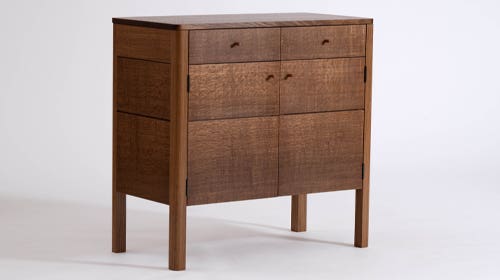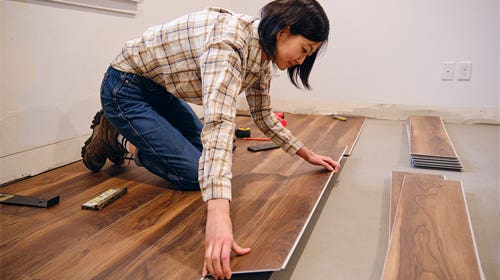Some straight talk about warped wood
In the July 2008 issue of Woodshop News (page 16, “Finishing both sides is warped thinking”), finishing columnist Bob Flexner said: “It’s a widespread myth among woodworkers and finishers that…
In the July 2008 issue of Woodshop News (page 16, “Finishing both sides is warped thinking”), finishing columnist Bob Flexner said: “It’s a widespread myth among woodworkers and finishers that to prevent warping it’s necessary to balance moisture-vapor exchange by finishing both sides of wood. In fact, finishing the undersides of tabletops or the insides of cabinets or chests has only limited impact on reducing the likelihood of future problems.”
After such an opening you might expect to have the results of some extensive tests on a variety of panels using a variety of finishes Flexner had conducted. Instead he went on to explain three causes of warping in wood. A reader who didn’t know better could have accepted these explanations as true, but they are not.
Why wood warps
Wood warps because it shrinks as it loses moisture. If it shrunk evenly on both faces and both edges of the board, it would remain flat. But it doesn’t shrink evenly on all four surfaces. It shrinks about twice as much in the tangential plane or direction as it does in the radial plane or direction. We call this mismatch shrinkage differential, and it is the cause of wood distortion or warping.
A flat board, as it dries, can change its shape in four ways. It can cup, bow, spring or twist. It also can split, and square stock goes into a diamond shape.
Don’t imagine that wood limits itself to selecting one item on the warping menu; it can cup, split and twist all in the same board. However, by now we have a pretty good handle on drying wood to minimize distortion.
When a board is sawn from a log prior to a trip through a kiln or a period standing in a stack to air-dry, it is saturated with moisture. It can have a moisture content of 100 percent. That is to say that there is as much weight of water in the board as there is weight of dry wood tissue.
Calculating moisture content
A sample of wood is weighed. It is then dried in an oven until there is no more loss of weight. Subtract the dry weight from the original sample weight and you have the weight of water.
Drying wood
The board is nothing more than a huge bundle of wood cells that are the structural elements of wood. You might think of it as a bundle of straws of all shapes and sizes because the minute elements or cells of wood have walls like a tube with a space up the middle.
The space up the middle, the cavity, is full of moisture — it’s called “free water.” The walls of the cells or tubes or straws are full of moisture — it’s called “bound water.” In the drying process, the free water comes out readily, like the water out of a bottle. There is no change in the dimension or geometry of the board. It is impossible to remove all the moisture in the cell cavities without some of the moisture in the cell walls being removed.
At about 30 percent moisture content the free water is out, and now the bound water has to be taken out. It’s a theoretical state, but for practical purposes we consider 30 percent moisture content the point at which the free water is out and this is known as the “fiber saturation point.”
After this point, the wood is going to shrink as it dries because you are taking moisture out of the walls of the straws. And it shrinks more tangentially than radially. However, with careful drying, which in a kiln means the proper control over the humidity, the temperature, and the air movement, distortion can be kept to a minimum. In an air-dried stack, it means correct sticker dimension, stack orientation, end grain blocks and a good weather cover to minimize distortion.
From boards to parts
Whether you are in quantity production or small production and whether from kiln or air-dried stack, the imaginary board we began with needs to be conditioned to about 8 percent moisture content depending on where you are in the U.S. Next, it’s going to be cut up into parts and dimensioned to be flat and square. With changes in relative humidity, the pieces will shrink and expand but they will retain their shape until selected for use in the construction of a product.
In other words, shrinkage and warping shouldn’t be discussed as though they were synonymous. You get beyond warped parts in furniture making at the selection and the preparation of the stock stage. You can never get past shrinkage and expansion. Because wood reacts to relative humidity in this way it is said to be “hygroscopic.” Once its moisture content is in sync with the relative humidity, it has reached “equilibrium moisture content.”
Solid wood furniture design
The design of solid wood furniture has long been dictated by the hygroscopic nature of wood, starting with the frame and panel. Tabletops are held down by small blocks of wood called “buttons” that allow shrinkage and expansion to happen. There is a metal version of the button used on less expensive products.
In the photograph on page 17 of Flexner’s article, we are told, “When wood is wetted and dried repeatedly, as has clearly happened with this tabletop, the surface shrinks because of compression shrinkage and the wood warps (cups) and splits.”
Subjecting wood to extremes of moisture, heat, abrasion, chemicals or a combination of them by repetition will cause it to behave uncharacteristically. From the look of this small table it doesn’t appear to have a very august pedigree. We might ask how well was the top material selected and how well was it held down to the frame? Whatever the answer, it looks to have been misused and has distorted by cupping on one edge.
The cupping can be attributed to normal reasons, but not for the one given: “When the finish on tabletops and floorboards is too thin or becomes worn or crazed and doesn’t adequately prevent water penetration, the cells near the surface go through compression shrinkage and the wood eventually cups.”
The top was never in compression and the explanation of compression in Flexner’s column (paragraphs 18 and 19) is a loose explanation of what is known as “permanent set.” This occurs when you drive wood into a space smaller than its dimension. For instance, a round chair leg forced into a hole in a seat or a handle into a hammer head. When the compressed wood loses moisture it shrinks and the assembly becomes loose. However, because the tissue is so disturbed by the compression when the relative humidity rises and it should expand, it doesn’t and it never will.
Flexner also made the following assertion: “Cupping occurs on single-sided veneered panels because of the use of a water-based adhesive. The water swells the veneer as it is being laid. When the veneer then dries out, it shrinks, drawing the panel into a mildly cupped warp.”
In reality, the veneer has very little strength. Slicing it from the log causes compression cracks on one side and tension cracks on the other. What happens is that the liquid adhesive was converted from a liquid into a film by rolling it onto the panel. The liquid in the adhesive evaporates and the glue film shrinks, causing the panel to cup. If you roll glue onto a panel and leave it to dry — no veneer — it will cup.
Ian Kirby is a woodworker, designer, author and teacher, and holds a certificate of the Institute of Wood Science.







